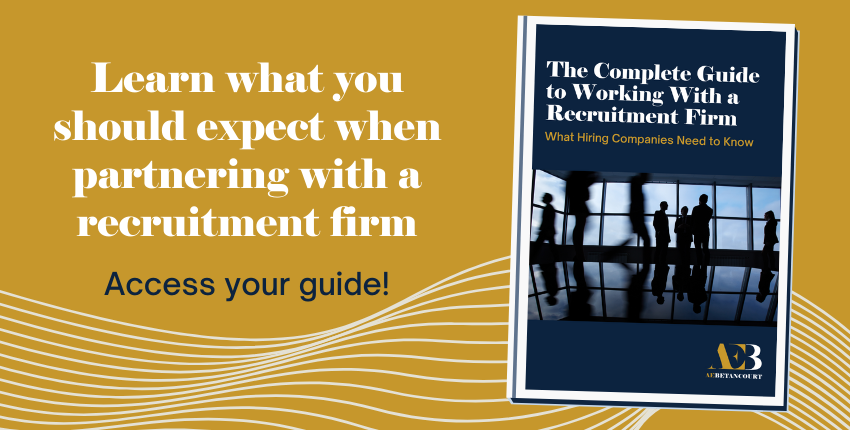Historically, the recruiting industry has had a bad rap and has long suffered from not only a lack of transparency, but innovation, prompting negative sentiments toward recruiters and search agencies alike. Unfortunately, the negative sentiments are often deserved. Recruiters are frequently bad-mouthed for their reliance on hard sales techniques and candidates often report they don’t feel heard, or worse, they are just a number fulfilling a recruiter’s quota for placements.
Let’s face it. The recruiting industry generates $150 billion in revenue but has the client satisfaction rate of a cable company. The industry has the potential to provide better outcomes for hiring companies. Keep reading as we take a look at some of the challenges the recruiting industry faces and how, as part of the industry, we can navigate positive change.
The Conflict of Interests in the Recruiting Industry
Recruiters should aggressively be more transparent with hiring organizations, but that doesn’t serve them well. Recruiters are incentivized to get you to hire someone, whether or not it’s in your best interest — and most often at the highest price possible. That’s because the higher the salary, the higher the recruiting fees.
Recruiting high-quality talent is typically ranked as a number one concern of a CEO, but it’s not being done well across the board, and there is growing friction between hiring managers and recruiters. The root cause for that friction is a lack of transparency, specifically around the fee structure within the recruiting industry and how this impacts the work being done for organizations.
For context, there are two primary fee structures in the recruiting industry:
-
Contingency fee: Recruiters typically get a percentage of the candidate’s first year of compensation. That percentage can be around 25-30%, sometimes up to 50% depending on the position.
-
Retainer fee: There is a flat fee to hire. Organizations will pay recruiters a retainer before the search services for professional placement have started, a second payment when a shortlist of viable candidates is provided, and then a final payment once a candidate is hired.
On the surface, neither of these fee structures is inherently malign, but the lack of transparency around fees and the way they impact how a candidate interacts and works with an organization is definitely a problem.
Recruiters should share all their potential candidates with you, but that’s not in their best interest. Without significant transparency in who exactly recruiters are screening or even the scope of their work, there are a lot of questions as to what’s being done and what organizations are even paying for.
Candidate exclusivity is not always a guarantee either, and that can lead to major problems for organizations in highly competitive industries.
The reality is recruiters should be incentivized to send a candidate to the best culture. However, they are more often incentivized to send a candidate to a company offering a higher compensation because that means they’ll retain a higher fee. The fee structure creates a domino effect of issues for the recruiting industry.
When recruiters only get paid for who they place in organizations, many take on more contracts or funnel more candidates to organizations without taking the necessary time to figure out whether the candidate is a perfect fit. And it goes without saying — bigger clients with bigger searches and bigger fees will prompt recruiters to put in more time and effort. It’s not always easy to find recruiters committed to your organization and committed to doing the best work.
But all this isn’t to say the fee structures need a complete overhaul or that there is no place for recruitment firms and search agencies. The recruiting industry is critical to the labor market, but organizations will have to demand better outcomes and see that those outcomes are possible.
Getting Better Outcomes Starts with the Right Questions
Partnering with a reputable recruitment firm should provide a company with more than just a resource for finding and vetting candidates. The right search firm should provide strategic, organizational, and financial benefits to its clients — whether it’s direct competitive advantages, avoiding common pitfalls and missteps in hiring, providing counsel on onboarding and hiring processes, and lowering the costs of open positions within an organization.
The problem many organizations run into is knowing how to vet a recruitment firm to know whether it’s the right fit for the job.
First, ask the agency if it can and will share its process for defining and understanding the criteria for a perfect-fit candidate. If the agency doesn’t have a process, it is not the agency for you no matter how well-known they are in the recruiting industry. How can you expect someone to help you find top talent if they don’t understand what exactly that means for the organization and what that will look like in potential candidates?
Second, ask the agency if it can and will share with your organization the work that is being done on a daily basis. Figure out how transparent it is willing to be about its process and the candidates it is working with. Ask the agency how often you’ll hear from it and even how many other searches it is working on within your industry.
Knowing what questions to ask and determining how transparent your recruitment firm will be about its process will indicate whether you’ll see consistent results.
How the Recruiting Industry Should Change
There is a more intentional way of recruiting and retaining top talent, and it has to become the norm.
It should be normal to engage with a firm that shares its data with you, communicates with you, and dedicates resources to you. And when more organizations realize a better experience is available, the industry and its perceptions will begin to shift.
If you are just beginning to explore partnering with a recruitment firm for your business, or you are questioning the level of service and support you are getting now, this guide can help. Learn the essential elements needed to make informed decisions.


.png)
.png)
.png)
.png)
.png)


